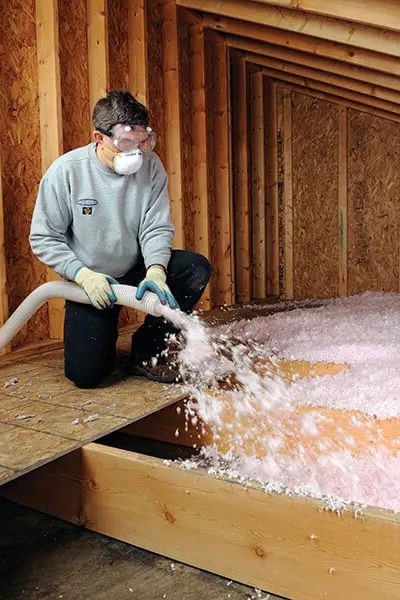Blown-in insulation is one of the most popular types of home insulation because it fills every nook and cranny that other types can’t reach.
But here’s the big question: what blown-in insulation is best for your home? The answer depends on your budget, your home’s age, and what matters most to you: efficiency, eco-friendliness, or easy installation.
Let’s break down the differences, pros, and cons so you can make a smart, stress-free decision that keeps your home comfortable year-round.
Types of Blown-in Insulation
Blown-in insulation isn’t one-size-fits-all. There are several materials you can choose from, each with its own benefits, drawbacks, and best use cases.
The main types are cellulose, fiberglass, mineral wool, and spray-in (or loose-fill) foam insulation. Knowing the differences helps you pick the right one for your home’s comfort, energy savings, and budget.
Cellulose Blown-In Insulation
Cellulose is the go-to choice for many homeowners who want something eco-friendly and effective. It’s made from recycled paper that’s treated with fire retardants to make it safe for home use.
One of cellulose’s biggest advantages is how tightly it packs into small spaces, which helps block air leaks and improve efficiency. The only downside? It can absorb moisture if your attic or walls aren’t sealed properly, leading to settling over time.
Best for: Older homes, attics, and spaces with odd shapes or gaps that need dense coverage.
Fiberglass Blown-In Insulation
Fiberglass insulation is made from fine glass fibers that trap air to slow down heat transfer. It’s lightweight, moisture-resistant, and doesn’t settle as much as cellulose. Because it’s easy to find and install, fiberglass is often the go-to choice for modern homes and large projects. However, it can irritate the skin and lungs during installation, so proper protective gear is a must.
Best for: Homeowners looking for affordable, long-lasting insulation that resists moisture and pests.
Mineral Wool (Rock Wool) Blown-In Insulation
Mineral wool, sometimes called rock wool or slag wool, is made from natural minerals or recycled industrial materials. It’s known for being fire-resistant and excellent at soundproofing, making it ideal for walls or ceilings near noisy areas. It performs very well but tends to cost more than cellulose or fiberglass. It’s also heavier and best installed by a professional.
Best for: Areas where fire safety, sound control, and durability are key priorities.
Spray-In or Loose-Fill Foam Insulation
Spray-in foam insulation (sometimes called loose-fill foam) is a newer option that expands to fill every crack and gap, creating a near-perfect air seal. It’s made from liquid foam materials that expand and harden, offering excellent insulation and air barrier properties. This type can be more expensive upfront, but it provides the highest energy efficiency and helps reduce air leakage more than cellulose or fiberglass. On the flip side, installation requires specialized equipment and professional expertise.
Best for: Homeowners who want top-tier energy efficiency, especially in hard-to-reach or leaky areas like rim joists or crawl spaces.
What Type of Blown-in Insulation is Best?
The truth is, it depends on your home’s needs, your budget, and your priorities. If you’re looking for something eco-friendly and budget-conscious, cellulose insulation is a solid pick. It’s made from recycled materials, easy to install, and offers great coverage for older homes.
For a cleaner, longer-lasting option that resists moisture and pests, fiberglass insulation often comes out on top. It’s lightweight, affordable, and perfect for attics or open spaces that need even coverage.
And if you want the most efficient, airtight insulation and don’t mind paying more upfront, spray-in foam wins for pure performance. It seals cracks, blocks air leaks, and provides the best long-term energy savings.
In short:
- Best overall value: Fiberglass
- Most eco-friendly: Cellulose
- Highest performance: Spray foam
Each one can be “the best” depending on what matters most to you: comfort, cost, or efficiency.
Blown-In Insulation vs Batts
Blown-in insulation and batt insulation (also known as blanket insulation) both use materials like fiberglass or mineral wool, but they’re installed very differently.
Batts come in pre-cut sheets that are rolled out between wall studs or ceiling joists. They’re easy for DIYers to install, but can leave small gaps or air pockets if not perfectly fitted. Blown-in insulation, on the other hand, is loose-fill material that’s literally blown into walls or attics using a hose. It covers uneven spaces and hard-to-reach corners much more thoroughly.
When it comes to performance, blown-in insulation typically provides better coverage and energy efficiency because it eliminates gaps. However, batt insulation wins on cost and simplicity, making it a solid choice for small, open areas or quick upgrades.
If you want easy, affordable installation, go with batts. For better air sealing and long-term comfort, blown-in insulation in Sarasota is the better pick.
Blown-In Insulation vs Spray Foam
This is where things get interesting. Spray foam insulation is known for its unbeatable air sealing and R-value (a measure of insulation’s resistance to heat flow). It expands to fill cracks and gaps completely, creating an airtight barrier that helps lower energy bills significantly.
Blown-in insulation, while effective, doesn’t create the same level of air seal. It’s more affordable, easier to install, and still provides excellent thermal performance, especially when used in attics or wall cavities.
The biggest difference is cost. Spray foam can cost two to three times more per square foot than blown-in fiberglass or cellulose. But over time, the energy savings may offset that higher upfront price. Choose spray foam insulation if you want maximum efficiency and airtight performance. Go with blown-in insulation if you want great coverage at a more budget-friendly price.
Blown-In Insulation vs Roll Insulation
Both blown-in insulation and roll insulation can help keep your home comfortable, but they shine in different situations.
Roll insulation (often made of fiberglass) comes in long, flexible rolls that you unroll over open areas like attic floors. It’s ideal for DIY projects since it doesn’t require special equipment. However, it can be tricky to fit around pipes, wires, or irregular framing.
Blown-in insulation, by contrast, can easily fill gaps, corners, and tight spots that rolls might miss. It’s especially useful for attics, wall cavities, and retrofitting older homes, where precision and full coverage matter most. When comparing cost and convenience, roll insulation tends to be cheaper upfront, while blown-in delivers better long-term energy efficiency thanks to its complete coverage.
How Long Does Blown-in Insulation Last?
One of the best things about blown-in insulation is that it’s built to last. When properly installed and kept dry, it can perform effectively for 20 to 30 years, sometimes even longer. The exact lifespan depends on the material type, climate, and how well your home is sealed and ventilated.
Fiberglass blown-in insulation is the most durable, often lasting up to 30 years or more with minimal settling. Cellulose insulation tends to settle faster and may need topping up after about 15 to 20 years, especially in attics where air movement is common. Spray-in foam insulation can last the lifetime of your home if installed correctly, since it hardens and seals gaps permanently.
The biggest threats to blown-in insulation are moisture and pest damage. Wet insulation loses its R-value (its ability to resist heat) and may clump or mold over time. That’s why it’s important to check your attic or crawl spaces every few years. A quick HVAC inspection can prevent small problems from turning into expensive repairs later.
Access the Best Blown-in Insulation Service in Florida
Choosing the right insulation can make a world of difference in your home’s comfort, energy bills, and indoor air quality. Whether you’re comparing cellulose vs fiberglass or wondering if spray foam is worth the upgrade, the key is having the job done right by professionals who know what works best for Florida homes.
That’s where Ties360 comes in. As a trusted insulation expert in Sarasota and other surrounding areas in Florida, Ties360 offers high-quality blown-in insulation services designed to improve your home’s efficiency, reduce energy waste, and keep every room comfortable year-round.
Their team uses top-rated materials and proven installation techniques to ensure your insulation lasts for decades, with no gaps, no settling, just consistent performance.
If you’re ready to make your home cooler in the summer, warmer in the winter, and more energy-efficient all year long, it’s time to take the next step.
Contact us today to schedule your blown-in insulation service and experience the difference professional installation makes.

